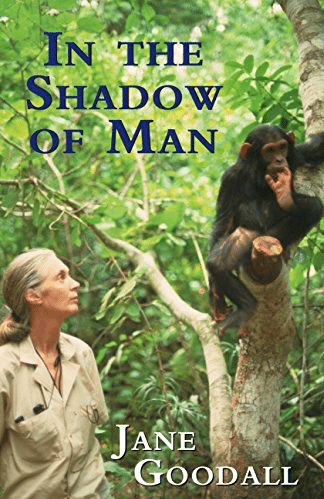A primatology book analysis and comparison to the PRC’s chimps by Taylor Luken.
Five to seven million years ago in Africa, humanity (Homo sapiens) and the African great ape known as the chimpanzee (Pan troglodytes) ceased sharing common ancestors. Our evolutionary divergence from chimpanzees and their status as our closest living evolutionary cousins have fascinated and inspired humans for centuries, prompting many to dedicate their lives to studying, protecting, or caring for these primates. As a result, there is a mottled and colorful range of books documenting humanity’s passion for chimps.
The Primate Rescue Center’s nine-member troop of chimps offers an intimate and special opportunity for those people willing to volunteer their time here to witness what many authors and scientists have observed over decades: the complex, compassionate, and even intellectual lives of chimpanzees.
 PRC chimpanzees (left to right): Donald, Noelle and Cory
PRC chimpanzees (left to right): Donald, Noelle and Cory
From primatology, ethology, and anthropology, to animal welfare, conservation, and even investigative journalism, the focus of many published works about chimpanzees varies greatly. But each depicts invaluable portrayals of the lives of chimps and offers to its reader the ability to interact with chimpanzees in an informed, empathetic, and self-aware manner.
Jane Goodall’s first book, In the Shadow of Man (1971), and her subsequent works are widely considered to be classic, foundational works in the realm of primatology. In the Shadow of Manmixes scientific observation with plain, emotional awe at the magnificence of living among wild chimpanzees. Goodall’s documentation of the Gombe Stream Chimpanzee Reserve’s residents can aid in identifying and comprehending the body language, vocalizations, and interactions of families of chimps. Goodall’s wisdom also helps strengthen arguments for endeavoring to conserve and protect their species in the wild and in captivity.

What Jane Goodall was the first to observe in the wild the staff, volunteers, and interns can observe at the Rescue Center; Goodall puts Ike’s pant hoots, Cory’s drumming, Jenny’s kissing, and Victoria and Zulu’s grooming into context and consequently makes their interactions even more meaningful!
 PRC Chimpanzees (left to right): Rodney and Zulu
PRC Chimpanzees (left to right): Rodney and Zulu
Dutch primatologist Frans De Waal has written several scientific works that delve into the evolutionary relationships between humans and chimps, as well as made arguments for recognizing a degree of intellectualism in chimpanzees. Our Inner Ape: A Leading Primatologist Explains Why We Are Who WeAre(2005) and Chimpanzee Politics: Power and Sex Among Apes (1982), respectively, are both brilliant and thorough results of De Waal’s life spent studying chimps.
The surprisingly refined and intricate hierarchal dynamics of chimps researched in Chimpanzee Politics makes spending time watching Donald, Ike, Rodney, and Cory display in their enclosure highly intriguing. Chimp politicking is also highly monitored by the feelings of the females towards the males. Strategies, coalitions, and social skills are as much a part of successful chimpanzee leadership as they are in human political maneuvering. While Donald is the current and fairly unchallenged dominant male at the PRC, the other males are consistently vying for different positions among the troop.
 PRC Chimpanzee: Donald
PRC Chimpanzee: Donald
Another great read, Animal Underworld: Inside America’s Black Market for Rare and Exotic Species (Alan Green, 1999), is a book written by an investigative journalist with personal experience with the Primate Rescue Center and the sanctuary’s work is featured in one of his chapters. While this book deals with primate species outside of chimpanzees, it presents the harsh and inhumane world of the U.S.’s pet and animal trade. Reading this brings to mind questions about how to help improve the lives of captive animals in America and ensure that carelessness and disregard for the lives of primates don’t continue to fester out of sight.

These books, along with many others unmentioned, exist as testaments to humanity’s enduring admiration for the chimpanzee. Works on human-chimpanzee comparative anatomy, evolutionary history, and other subjects have been being written since 1863, with Thomas Henry Huxley’s Evidence as to Man’s Place in Nature. And when looking into the curiously familiar eyes of Donald, Zulu, Victoria, Cory, Noelle, Ike, Jenny, Rodney, or Martina, it’s quite easy to tell why we have been so long enraptured by these remarkable creatures.